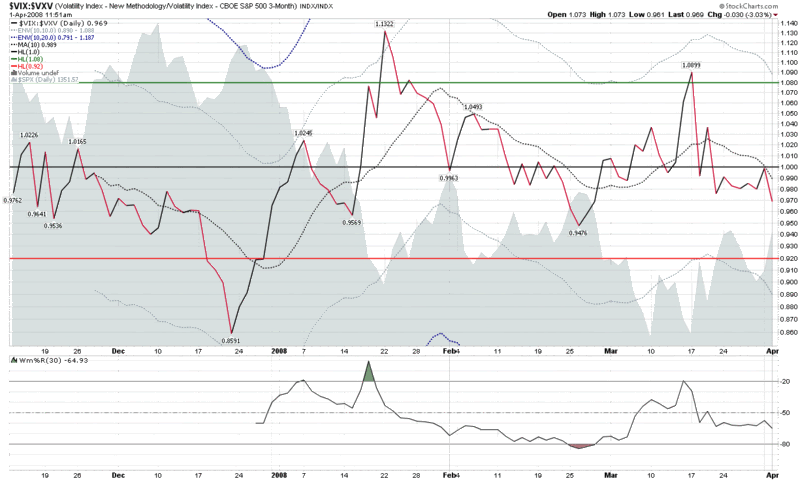Q Does VIX Follow Market Direction Options for Rookies
Post on: 26 Апрель, 2015 No Comment

Hi Mark,
Hi have a question about the VIX. Why is it that VIX increases and decreases more or less with the market rather than with the markets volatility?
For example, yesterday the market was significantly down, and VIX shot up. Today, the market was significantly up. Not quite as much as it went down yesterday, but VIX almost returned to where it started? Why are option sellers less concerned about upwards volatility than downwards volatility?
Thanks.
Russ
Markets tend to fall much faster than they rise.  That is not necessarily going to continue forever, but when it comes to trading options, perception is everything.
Thus, its not the markets direction, in and of itself, that drives volatility, its the actions of the people who buy and sell those options.
With the banks once again making major negative headlines, there was a real fear that the end of the world was at hand.  In those situations, option buyers dominate the activity.  Portfolio protection was needed.  Speculators wanted to buy puts. Investors panicked.
Under those conditions, market makers who are selling those options raise the bids and offers for all options.  When the buying stampede continues, prices rise again.  This is a very fair and ethical behavior.  If people are buying all you have to sell at one price and continue to bid for more, its foolish to maintain the price and get run over.  Raising prices in the face of demand is well understood in the stock market, and everyone must understand thats its just as reasonable when trading options.  Supply and demand play a role in the pricing of options.  When fear of a debacle is in the air, price is not a concern and those who feel they must own options pay any price to get them.
When markets rise, those fears are alleviated.  Whether this is reasonable or not, is not the issue.  The point is that call buyers are more patient and dont feel the need to panic.  Few fear missing an immediate market surge and thus, there are many fewer people who need to buy options right this moment.
With options at elevated levels and with few buyers, the sellers predominate.  Its not that they are anxious to force prices lower, but when there are more sellers than buyers, the market makers slowly but continuously drop the volatility number they use to calculate the value of the options they trade.  With lower theoretical values for the options, the computers that generate the bid/ask prices produce lower bids and offers.  Thus continues as long as there are far more sellers than buyers.  It also occurs when market makers are anxious to sell options believing the panic is over.
But keep in mind that the blind sale of options is risky business and in todays world, there are very few, if any, professional traders who want to accumulate big risk.  Most hedge their option trades as quickly as possible.  Nevertheless, when the markets rise, fear of a disaster goes away and option buyers are buying patiently, or not buying at all.
This doesnt continue forever.  At some point the sellers disappear and prices level.
But its fear of getting clobbered and the corresponding rush to buy puts that drives implied volatility (and VIX measures that) of the options.  And its not just puts call prices must rise also (to prevent arbitrage opportunities.
Addendum (9:16 AM)
Note that in todays selloff, RUT is lower by 12 points and RVX (the VIX of RUT options) is higher by less than 3 points.  Over the previous two days, it rose by 12 and fell by 9.  Thus, today theres no panic put buying (at least not yet).  The idea may be that weve seen these RUT levels recently and were not too afraid that it will go much lower.














